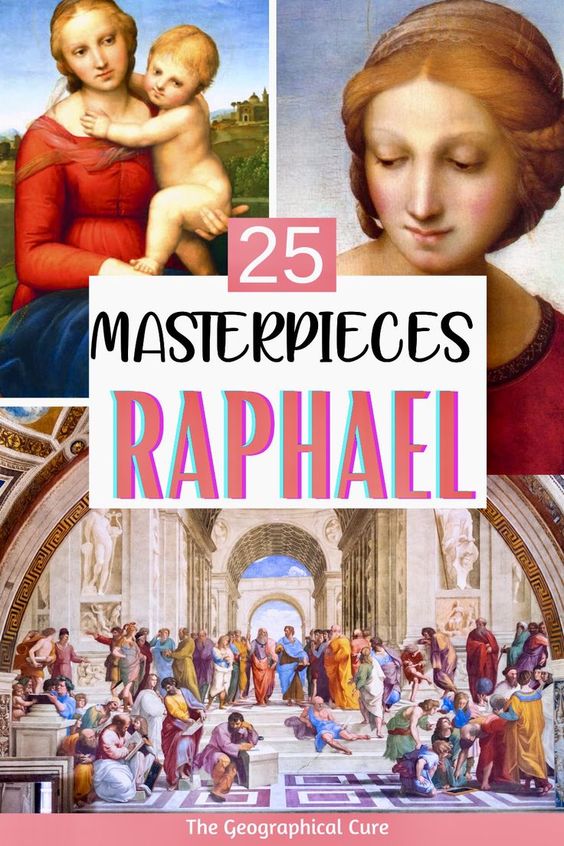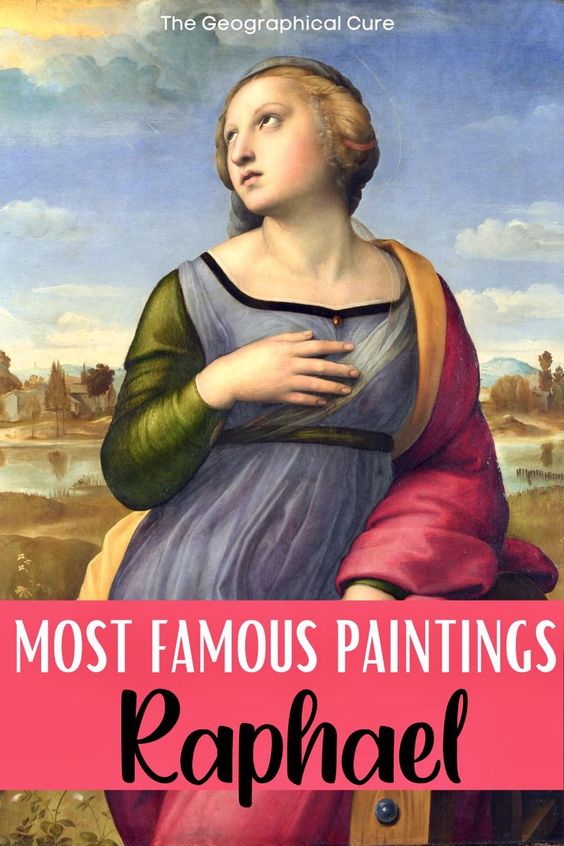Obsessed with the sublime Raphael, one of the greatest High Renaissance painters? Welcome to the club. So is much of society, judging from the recent hype over the 500th anniversary of his death.
In this Raphael guide, I take you an overview of Raphael’s life and his 25 most important paintings.
Raphael was one of the “holy trinity” of Renaissance painters, along with Leonardo da Vinci and Michelangelo. He burst on the scene in the early 1500s and became the most famous painter in Rome, and hence Europe.
Raphael’s self-portrait in Florence’s Uffizi Gallery
Nicknamed the “Prince of Painters,” Raphael’s compositions were serene and harmonious. He mastered the signature techniques of the High Renaissance — sfumato, perspective, anatomical correctness, and authentic emotionality and expression. To that, he added vivid color and clarity.
Raphael doesn’t get as much hype as his cohorts Leonardo and Michelangelo. Perhaps Raphael wasn’t as mysterious as the genius and dandy Leonardo. Or as famously surly and secretive as Michelangelo.
But Raphael was more prolific than those two artists. And was possibly the best pure painter of the trio, producing images of breathtaking beauty with genius compositions. He had an ever-evolving virtuosity. Raphael was beloved by his patrons because he almost always delivered on a commission.
He didn’t just create easel paintings either. Raphael also worked on the design and execution of monumental frescoes, tapestries, and was even the chief architect of St. Peter’s Basilica for a time.
A Short Biography of Raphael
Raffaello Sanzio was born in 1483 in Urbino. His father was a painter. Raphael grew up in the royal court of Urbino. It was a fairly sophisticated and humanistic court, a thriving center of the Renaissance.
There, Raphael polished his manners, sharpened his wit, and cultivated important connections. According to art historian Giorgio Vasari, Raphael had a sweet, even angelic, disposition. He was the antitype of a grumpy Michelangelo.
In 1504, at the age of 20, Raphael went to Florence. Florence was where all serious artists went to improve their skills and get artistic inspiration.
Raphael was apprenticed to the artist Pietro Perugino, one of the stars of the early Renaissance. Perugino created one of the most famous paintings in the Sistine Chapel, Christ Giving the Keys to St. Peter.
There’s no question that Raphael encountered the works of both Leonardo and Michelangelo when he was in Florence. Raphael’s then semi-stodgy style gave way to a more novel and complex style.
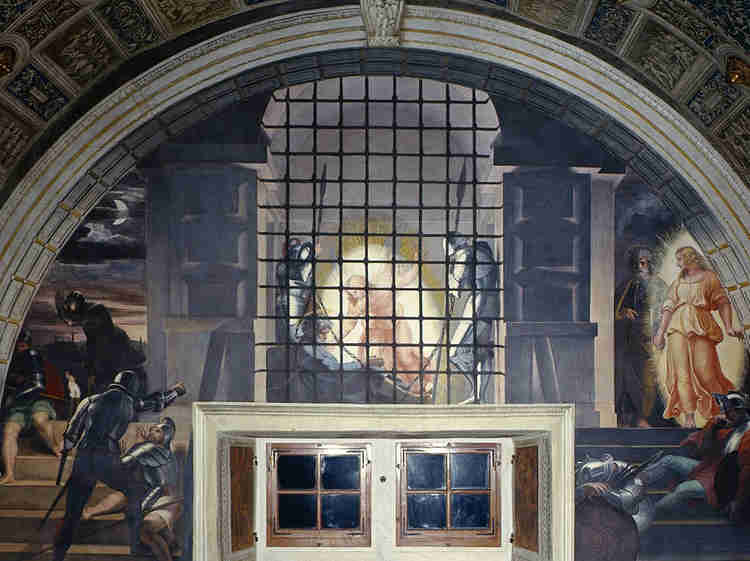
Raphael was a boy wonder and quickly gained fame. By his mid-20s, Raphael was already a star, known for his religious works and portraits. At the height of his powers, Raphael was thought to paint people “as more real than they really are.”
In 1508, Raphael was called from Florence to Rome by Pope Julius II. Raphael set to work on painting the pope’s apartments, now called the Raphael Rooms.
He would spend the last 12 years of his life in Rome, producing a massive volume of stunning art. Those years in the Eternal City marked the apogee of Raphael’s career.
Though Raphael is often described as genial, he was more complex than that. As his career trajectory revealed, Raphael could also be ambitious, competitive, and ruthless.
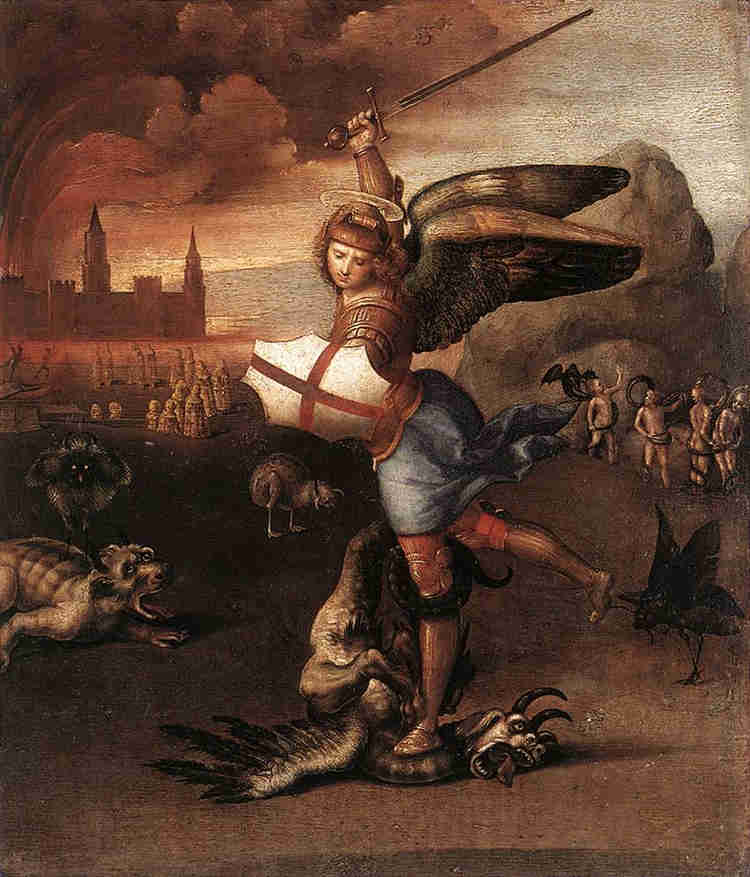
Raphael’s St. Michael in the Louvre
In each city he landed in, he became the best painter and received the plum commissions. He was confident, cultivating a well known workshop that helped him accumulate vast wealth and fame.
At the same time Raphael was painting the Raphael Rooms, Michelangelo was painting the Sistine Chapel. When Michelangelo was away in Florence, Raphael snuck a clandestine look at the ceiling, with the help of his ally Bramante.
As always, Raphael absorbed the new techniques. Michelangelo would later say, enraged at the violation, that Raphael had stolen all his ideas. But Raphael absorbed influences and then produced work that was his own.
In 1517, Raphael began painting pagan frescos in the Villa Farnesina. “Raphael was a very amorous person,” wrote Giorgio Vasari, Raphael’s first biographer. Vasari had never actually met Raphael. But he helped cement the legend of Raphael as a lothario.
READ: Guide To Villa Farnesina
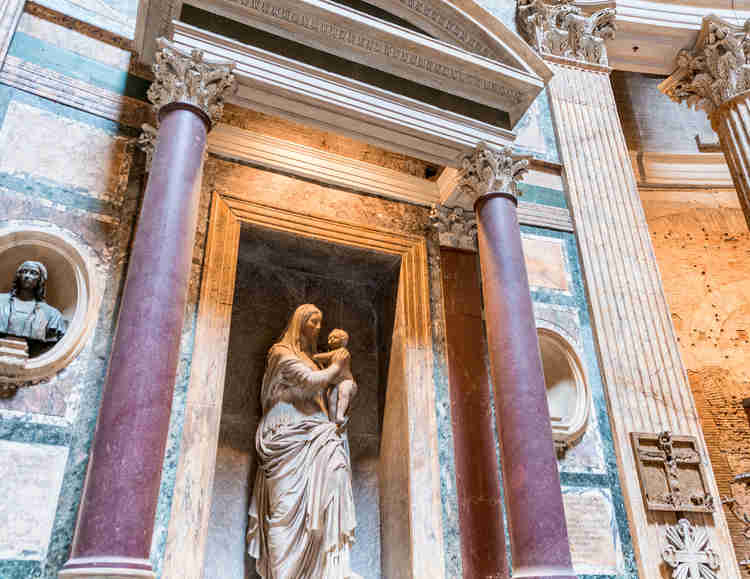
Raphael’s tomb in the Pantheon
Though reluctantly betrothed to the niece of a powerful cardinal, Raphael eluded the snares of matrimony. In 1517, Raphael began a torrid affair with Margherita Luti, the baker’s daughter who lived down the street from Villa Farnesina in Trastevere.
Luti modeled for him and was later immortalized in famous paintings. In fact, Raphael’s madonnas all seem to have the same face. That may mean that Luti was Raphael’s muse, the same way that Simonetta Vespucci was Sandro Botticelli‘s muse.
In 1520, Raphael died abruptly at 37. The diagnosis back then? According to Vasari, “too much sex” with Luti caused Raphael to spike a fever and die. More likely, however, an over-worked Raphael died of exhaustion, bloodletting, and pneumonia.
When news of the handsome young artist’s death broke in Rome on April 6, 1520, Pope Leo X wept. Church bells tolled all over the city. Raphael was buried in the Pantheon, after a funeral procession with one of his most famous paintings, The Transfiguration.
Raphael’s tomb is just to the left of the Pantheon’s main altar. It’s adorned with one of his student’s sculptures, Madonna del Sasso. His bronze bust is in a niche above his grave to the left. The tomb to the right is Raphael’s fiance, Maria Antonietta di Bibbiena, whom he likely never intended to marry.
READ: Complete Guide To Rome’s Pantheon
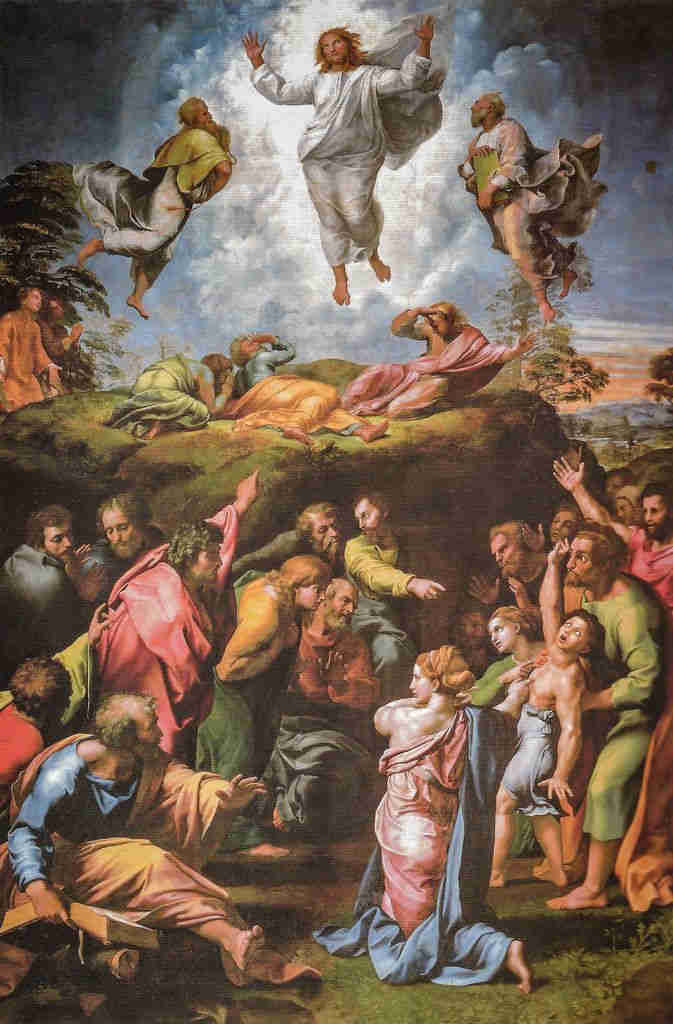
Raphael’s Transfiguration in the Vatican Pinacoteca
Top Masterpieces And Famous Paintings By Raphael
Here’s my list of Raphael’s best must see paintings, for your art bucket list. Raphael’s painting are in the most famous museums of Europe and the United States.
READ: Guide To the Best Small Museums in Europe and the US
1. Transfiguration, 1520 | Vatican Pinacoteca, Vatican City
The beautiful (and gigantic) Transfiguration is Raphael’s last known painting. It was commissioned by Cardinal Guilio de Medici, who later became Pope Clement VII. The dramatically lit painting was critically acclaimed. The chiaroscuro and color is the height of Raphael’s work.
The painting combined two biblical narratives. It tells the story of Christ leading his disciples up a mountain to show them his true form, a being of pure light. He’s flanked by Moses and Elijah. At the bottom, it also depicts a miracle — when Christ exorcized the demons of a young boy suffering from lunacy.
Why is the Transfiguration important? It bridges the period between the High Renaissance and the Baroque. It’s notable for its use of chiaroscuro (the effect of contrasted light and shadow), skill in composition, and expressiveness. It inspired legions of French painters.
In this extraordinary painting, Raphael synthesizes the influences of Michelangelo and Leonardo. If you don’t make it to the Vatican Pinacoteca, there’s a beautiful mosaic copy of The Transfiguration in St. Peter’s Basilica.
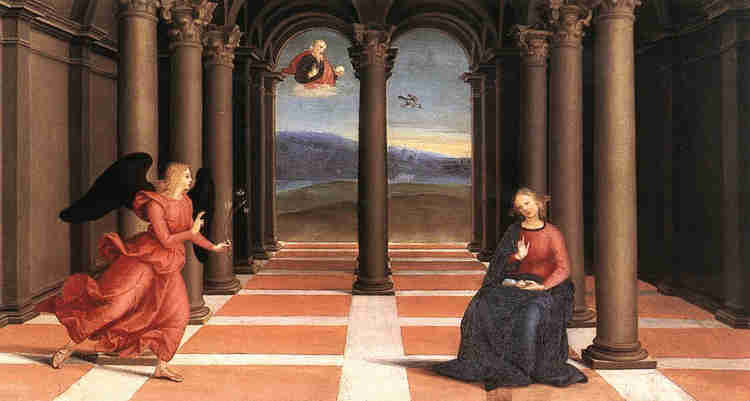
Raphael’s Annunciation in the Vatican Pinacoteca
2. The Annunciation, 1502-03 | Vatican Pinacoteca, Vatican City
The Annunciation is one of Raphael’s earlier works. It’s on display in room 8 of the Vatican Pinacoteca. Originally, the Oddi family commissioned the painting for its family chapel in Perugia.
The painting depicts the classic annunciation scene, where the angel Gabriel tells Mary of the coming of Christ. But, in the background, two open arches look out onto a landscape.
This gives the painting a three dimensional perspective — highly unique for that day. In the upper left corner, God looks down, stealing the focus from Mary.
Always with an eye for great art and itchy fingers, Napoleon seized The Annunciation and displayed it in the Musee Napoleon, a one time name for the Louvre. The painting was returned to Italy in 1815 and placed in the Pinacoteca.
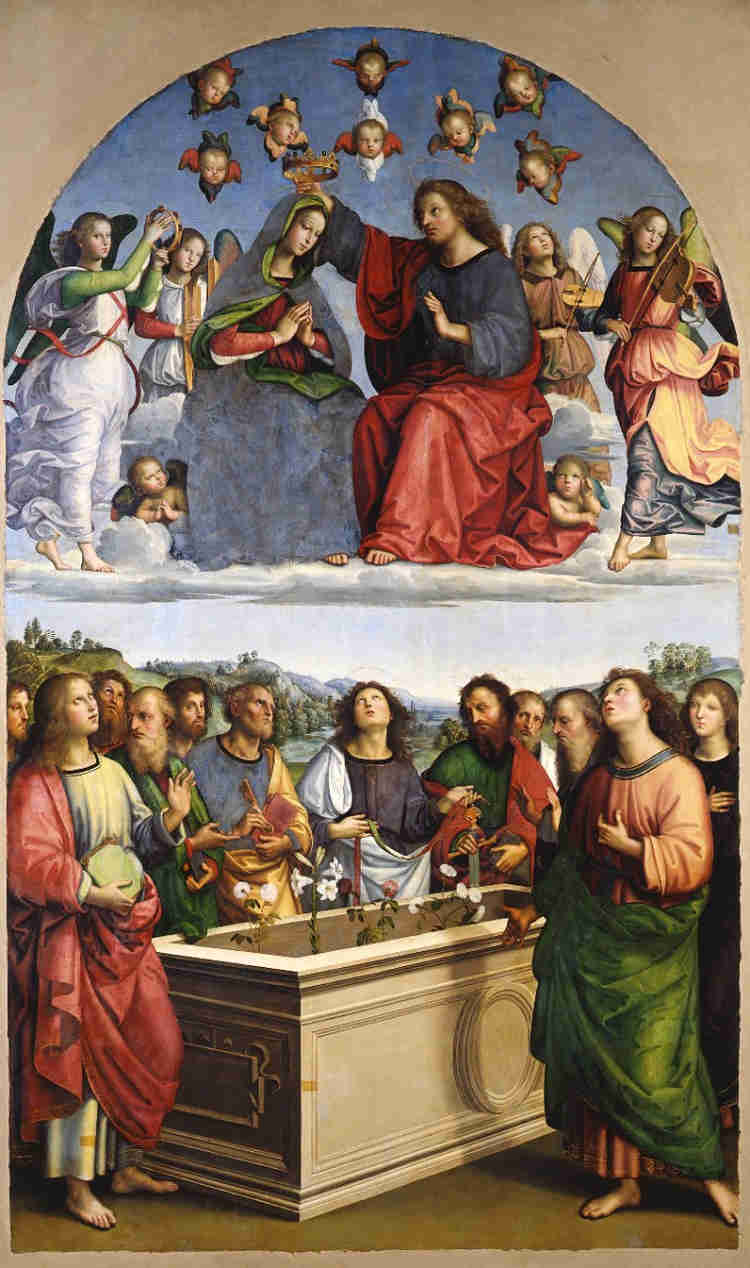
Raphael’s Coronation of the Virgin in the Vatican Museums
3. Coronation of the Virgin, 1502-04 | Vatican Pincacoteca, Vatican City
This is an early Raphael painting, rendered when he was just 19. It shows the influence of his teacher Perugino, with whom he’d just completed an apprenticeship. It’s a mix of imagery with kewpie doll faced figures.
The panel has two zones. At the top, you see a coronation. Jesus puts a crown on the head of a beautiful figure of the Virgin Mary.
At the bottom, the apostles surround an empty tomb intended for Mary, which is rendered rather audaciously in a diagonal position. They glance up at the proceedings above. The faces are almost portrait-like.
Raphael’s colors are very subdued, in the style of Perugino. But, after executing this piece, Raphael went to Florence to study the art work of Leonardo. Then, he goes to Rome. There, Raphael is exposed to the Michelangelo frescos in the Sistine Chapel. Later, he uses more vibrant colors.
Raphael’s School of Athens
4. Raphael Rooms | Vatican Museums Vatican City
The Raphael Rooms are a magnificent assemblage of Renaissance frescos, one of the world’s most famous Renaissance interiors. Hired by Pope Julius II, a precocious young Raphael and his assistants (especially Giulio Romano) painted dramatic frescos in four rooms in the pope’s apartments between 1508-24.
The four Raphael Rooms, also called the Raphael Stanza, are: the Room of Constantine, the Room of the Signature, Room of Heliodorus, and the Room of the Fire of Borgo. Raphael’s frescos are just as important in art history as Michelangelo’s Sistine Chapel.
The School of Athens is the undisputed star of the Raphael Rooms. School of Athens is Raphael’s most famous and beloved painting. The painting has come to symbolize the marriage of art, philosophy, and science — a hallmark of the Italian Renaissance.
In it, an idealized throng of the great philosophers from the classical world are gathered together, despite living at different times. The cast members converse, argue, scribble, read, and declaim on a sprawling film-like set. The viewer is fully engulfed in the painting, in theatrical style.
Here’s my complete guide to the Raphael Rooms in the Vatican Museums, which describes 13 of the magnificent paintings in the Raphael Rooms.
Raphael’s Woman With a Veil in Florence’s Pitti Palace
5. Woman With a Veil, 1516 | Pitti Palace Florence Italy
This is a stunningly beautiful Raphael, perhaps my favorite. What makes the painting so famous? For starters, La Velata shows Raphael at the peak of his power. His artistic mastery is writ large in every detail.
The white and gold painting is beautiful, refined, and exudes a physical warmth and sensuous vitality. Covered by a sumptuous piece of cloth, the subject has a mysterious look.
Even her clothing seems alive. You can almost feel the weight of her veil. A single strand of hair escapes from her veil.
Art historians don’t know the identity of the woman. This is odd because Raphael commanded hefty commissions for famous families, who would have required their family name to be front and center. It could simply be a painting of Margherita Luti that Raphael painted for love.
Unlike much of Raphael’s other work, this is an intimate portrait. The woman’s right hand rests over her heart and her left hand between her legs. It’s a Venus-like posture reminiscent of The Capitoline Venus in Rome’s Capitoline Museums, equating La Fornarina with the goddess of love.
READ: Complete Guide To Florence’s Pitti Palace
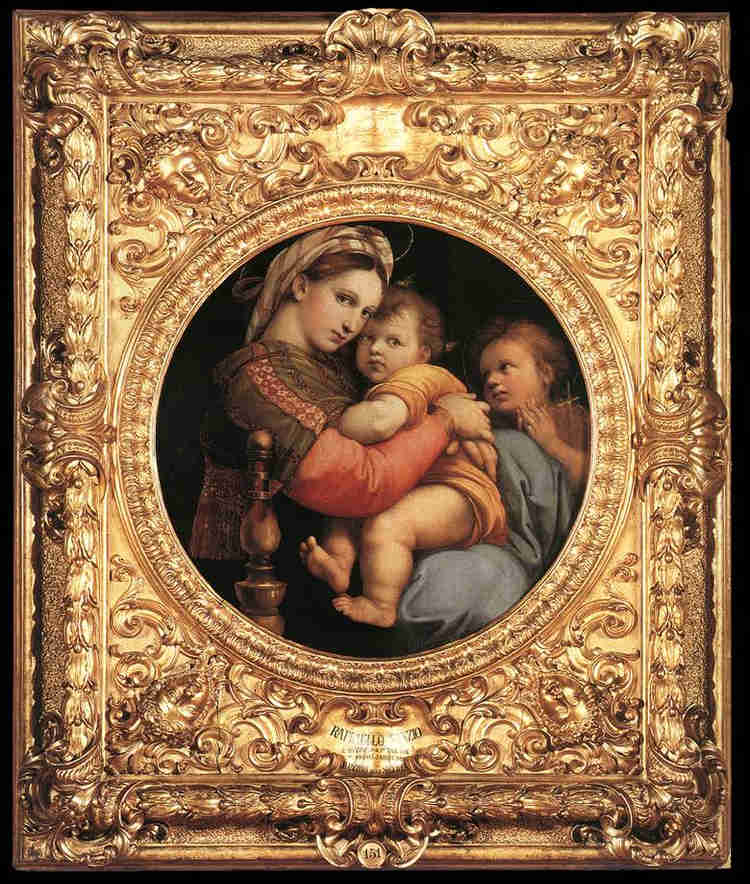
Raphael’s Madonna of the Chair in Florence’s Pitti Palace
6. Madonna of the Chair, 1513-14 | Pitti Palace, Florence Italy
This is Raphael’s most famous madonna. It’s a vivid and intimate image executed at the height of his powers, when Raphael was known as the “Prince of Painting.”
It’s a celebration of motherhood, an intimate scene between mother and son, with a reverent St. John the Baptist watching as per usual. The curves of the panel are repeated in the arrangement of the figures, rounded almost like sculptures.
Characteristic of Raphael, the color is clear and brilliant. There are no extraneous details. Mary is dressed like a peasant, not a madonna, which was very unusual for the time. Christ has an abundant fleshiness, his arm gently tucked into his mother’s shawl, a detail that seems drawn from real life.
The painting may have originally have just been a mother and son bonding painting. But, back then, everything was required to have a religious component. Raphael may have slapped on a couple halos and added St. John the Baptist to complete the expected tableaux.
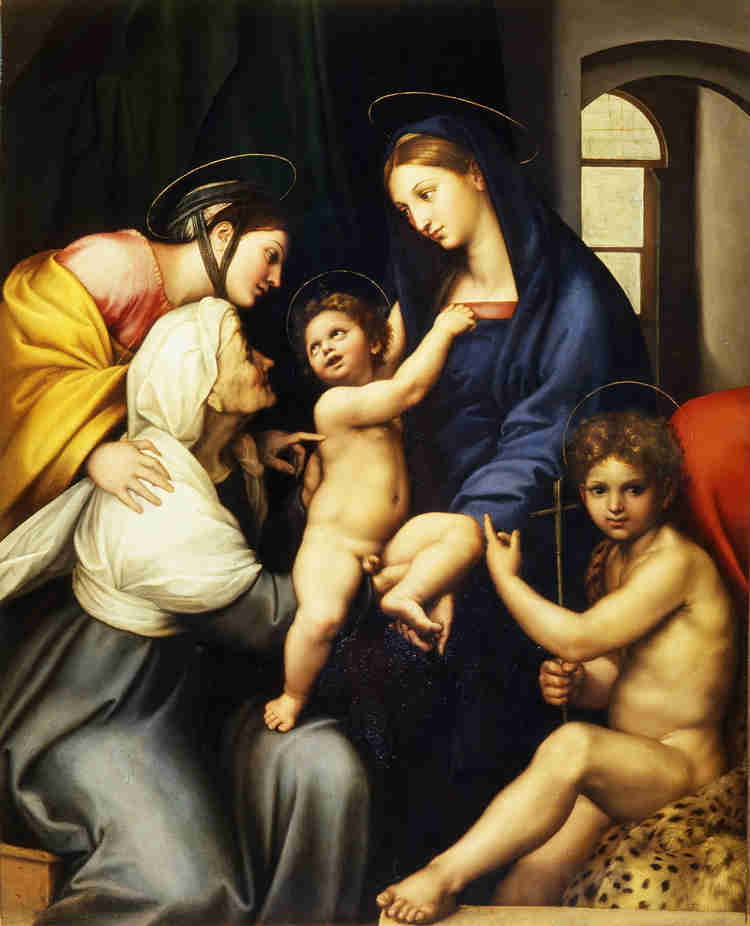
Raphael madonna in the Pitti Palace
7. Madonna dell’Impanata, 1513 | Pitti Palace, Florence Italy
This is a simply beautiful Raphael painting on linen. It’s in his mature style, with a magnificent use of color and light to portray real life. There’s sfumato and chiaroscuro, and attention to feminine beauty.
The composition includes a madonna, child, and saints. A rather erotic St. John the Baptist is on the bottom right with his left foot propped up. Sitting on a fancy leopard fur, he looks a bit too old to be naked. His left hand grazes Christ’s knee.
Even as a child, Christ is shown in a contrapposto position, looking at his grandmother and aunt.
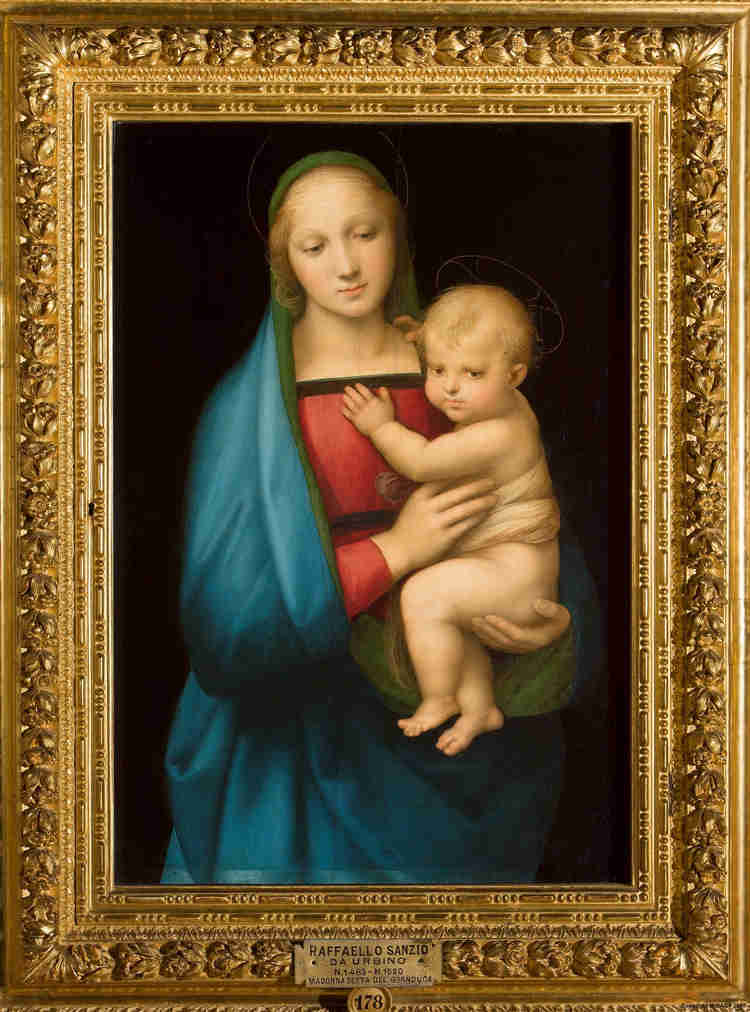
another Raphael madonna in the Pitti Palace
8. Raphael, Madonna del Granduca, 1506-07 | Pitti Palace, Florence Italy
This is an early, but very moving, painting by Raphael. We don’t know who commissioned the piece. The work was painted during Raphael’s stint in Florence. It appears to be influenced by Leonardo, using a sfumato (blurring of colors) technique.
READ: 30 Must See Masterpieces in Florence
In it, Raphael demonstrates all his skills in depicting holy subjects. In spite of its simplicity, there’s a sentimentality and delicate beauty to the piece. The sweet Christ child looks out at us poignantly. Both mother and child wear simple halos.
Mary has a melancholy visage and slightly tilted head, perhaps reminiscent of Botticelli most famous paintings. Yet, her gaze is directed outward, perhaps inviting you to view her cherubic baby and his sweet face.
The dark background isn’t original. The original background is shown on Raphael’s preparatory drawing in the Uffizi. The black background was painted on to make Raphael look like a precursor to Baroque superstar Caravaggio.
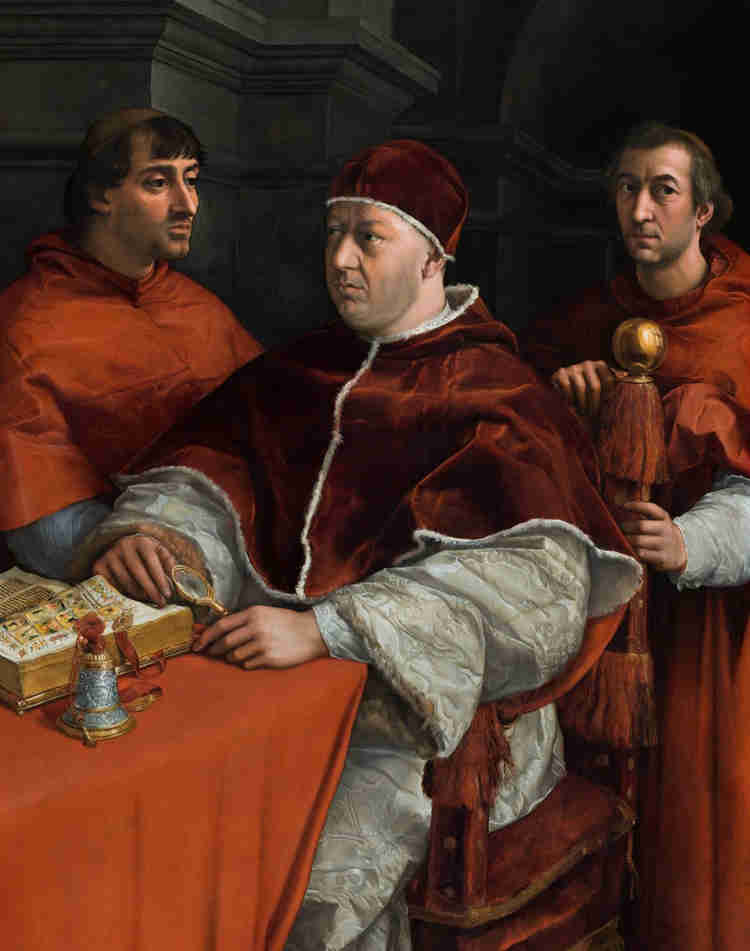
Raphael’s Portrait of Pope Leo X
9. Portrait of Leo X, 1516 | Pitti Palace, Florence Italy
Leo X is one of Raphael’s most important Renaissance portraits. After a clumsy 19th century restoration, experts confirmed “without a doubt” that the two cardinals were, in fact, painted by Raphael.
The Pitti Palace received the painting in a “trade” with the Uffizi Gallery in exchange for the acclaimed Raphael double portrait of Agonoli Doni and Maddalena Strozzi, which is now on display in the Raphael and Michelangelo Room of the Uffizi.
The portrait is a symphony of reds. There’s no chaos in the painting.
But it depicts two of the worst popes in history. Pope Leo X once claimed, “Since God have given us the papacy, let us enjoy it.” Leo’s policies would later lead to the Protestant Reformation.
The figures are depicted as dignified men. The painting is dominated by Leo X, in an unflattering portrait. He’s in sumptuous dress, an indicator of his penchant for excess. It’s possible the painting was sent from Florence to Rome, in honor of the wedding of Leo X’s nephew.
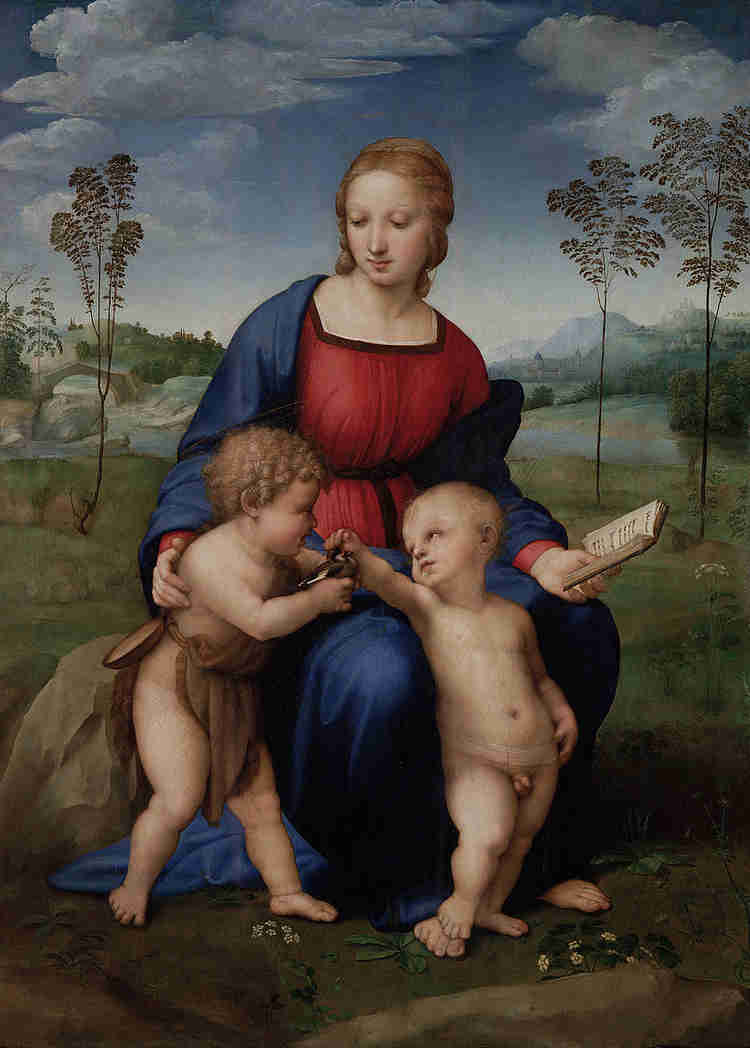
Raphael’s famous Madonna of the Goldfinch
10. Madonna of the Goldfinch, 1506 | Uffizi Gallery, Florence Italy
The Uffizi contains one of Raphael’s loveliest paintings, the serene Madonna of the Goldfinch. The sentimental painting shows Mary with a young Christ and John the Baptist. John holds a goldfinch, a potent symbol of the passion of Christ, of Christ’s suffering. It was influenced by Leonardo’s painting of the same subject from 1500 in the Louvre.
You can see a tenderness between mother and child. Christ puts his foot on his mother’s foot, as he (rather amusingly) stands in a staged and artificially elegant contrapposto pose. Mary doesn’t sit on a throne anymore, but a rock. Nature has taken on the expression of God, without kingly symbols.
Raphael’s Madonna is a survivor. In 1547, when the original owner’s house collapsed, the painting was shattered into 17 pieces. The work was only 41 years old.
Back then, an artist used nails to put it back together. The cracks were painted over numerous times during the following years. Five centuries later, the painting was a dour dusty brown and green. In 1998, a 10 year restoration returned the painting to its former glory — with Raphael’s trademark reds, royal blues, and gold.
READ: Complete Guide To Florence’s Uffizi Gallery
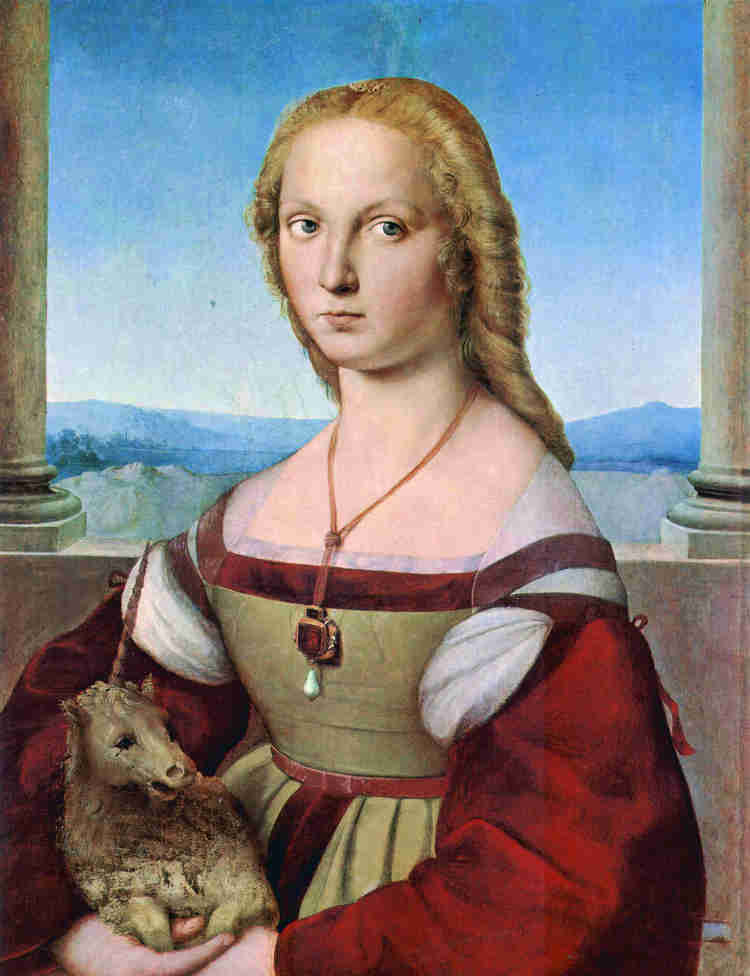
Raphael’s Young Woman With a Unicorn in Rome’s Borghese Gallery
11. Young Woman With a Unicorn, 1505-06 | Borghese Gallery, Rome Italy
Intended as a wedding gift, this Raphael masterpiece depicts the virtues and symbols of a young bride. The young Florentine woman in the painting symbolizes virginity and spiritual love.
Even the lap dog unicorn is a symbol of chastity. Medieval legends hold that only a virgin can tame a unicorn.
Raphael’s painting was clearly influenced by Leonardo da Vinci’s masterpiece, the Mona Lisa. Raphael used Leonardo’s half length format, the sitter’s folded hands, and added a beautiful landscape in the background. Unlike the Mona Lisa, however, the woman has a look of cool watchfulness rather than an enigmatic smile.
READ: Complete Guide To Rome’s Borghese Gallery
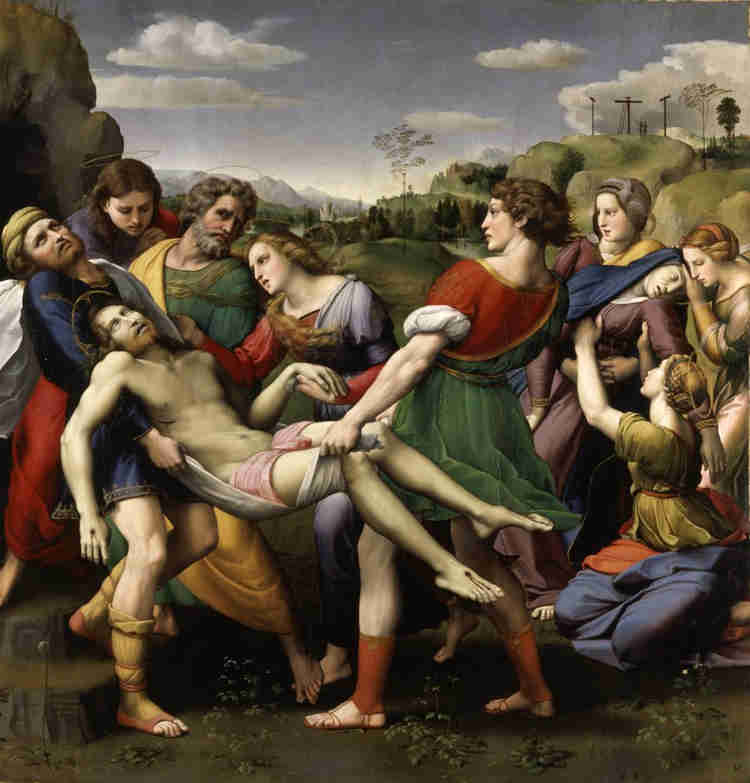
Raphael’s Deposition in the Borghese Gallery
12. Deposition, 1507 | Borghese Gallery, Rome Italy
Cardinal Scipione Borghese actually stole this Raphael painting, Deposition, from the altarpiece of a church in Perugi, to add to his personal collection. The cardinal told the victimized city that the painting was a gift for his nephew. When confronted with his theft, Borghese ordered a copy for the parishioners.
Raphael’s painting shows Christ being taken down from the cross. One woman faints at the tragedy, while another looks on in disbelief. Raphael’s figures are getting larger and there’s more dynamism and action in the painting.
The painting fuses the best of Raphael’s rich colors with a touch of Michelangelo’s physicality. Raphael had recently been in Florence and seen Michelangelo’s cartoon for the Battle of Cascina for the Palazzo Vecchio and his Doni Tondo.
READ: Guide to the Palazzo Vecchio
A hallmark of Raphael, the painting is ordered in harmonious geometric perfection. His lyrical figures exude a narrative pull.
Raphael double portrait in Rome’s Palazzo Doria Pamphilj
13. Portrait of Andrea Navagero and Agostino Beazzano, 1516 | Doria Pamphilj
This famed and austere double portrait is in the beautiful Aldobrandini Room of the Doria Pamphilj Palace. The museum is one of Rome’s hidden gems. The fashionably attired sitters were both Venetian men of letters and diplomats who had come to Rome
The men look us directly in the eye. The portrait was intended as a gift for the renowned humanist Pietro Bembo, who could thus virtually take part in the discussion with his magnificently portrayed friends, each pulsing with individualism.
Here’s my complete guide to visiting the Doria Pamphilj.
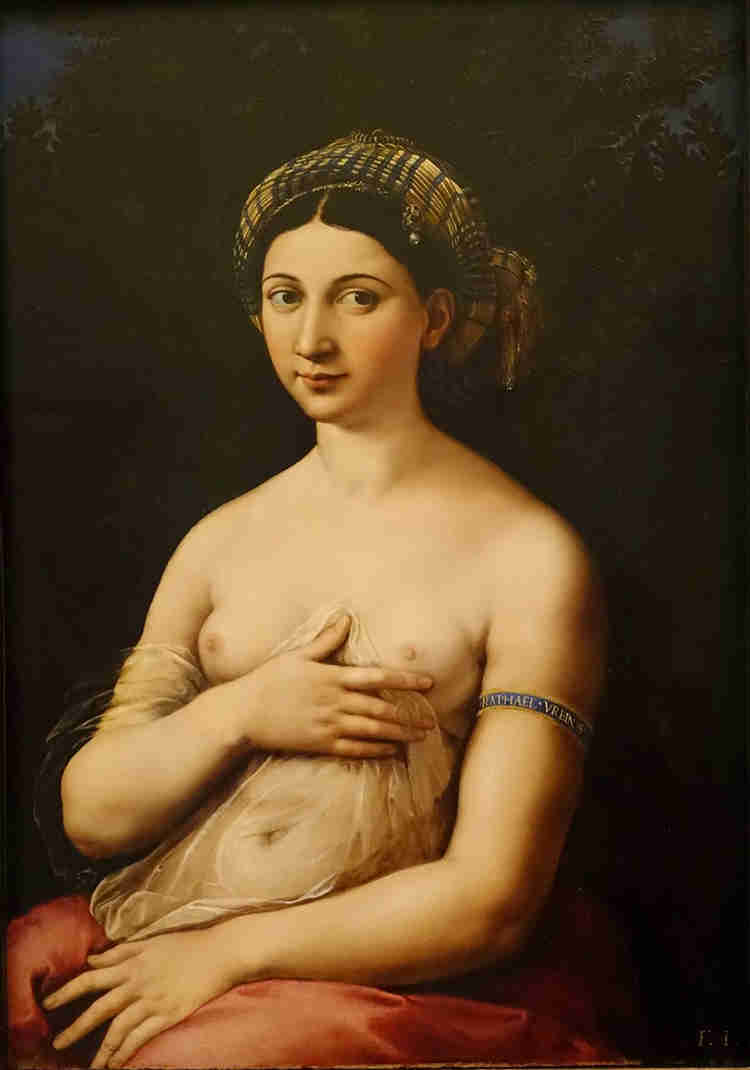
portrait of Raphael’s lover in Rome’s Palazzo Barberini
14. La Fornarina, 1518-19 | Palazzo Barberini, Rome Italy
This painting is the crown jewel of the Palazzo Barberini. What makes La Fornarina so famous? The painting is beautiful, refined, and has a torrid backstory.
It’a another portrait of the Raphael’s mistress, Margherita Luti, called La Fornarina. Unlike much of Raphael’s other work, this (like The Veiled Woman) is an intimate portrait. La Fornarina’s right hand rests over her heart and her left hand between her legs.
It’s a Venus-like posture reminiscent of The Capitoline Venus in Rome’s Capitoline Museums, equating La Fornarina with the goddess of love. Raphael even signed his name on her armband.
Here’s my complete guide to the Palazzo Barberini.
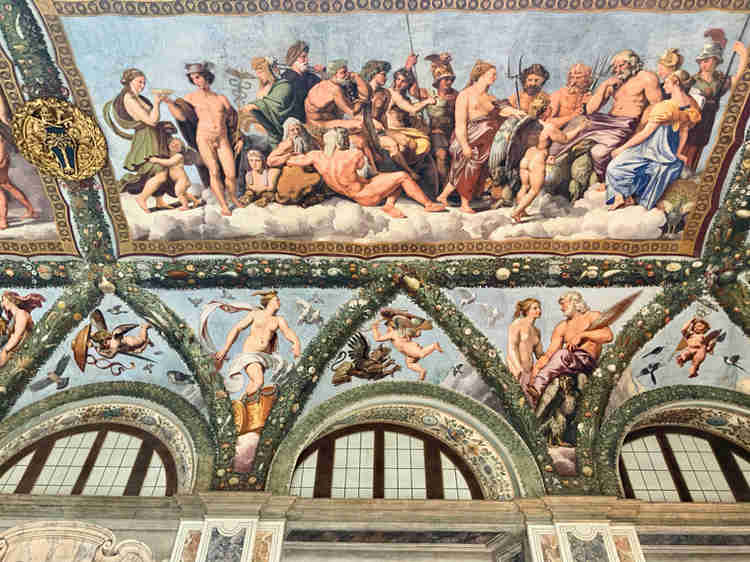
frescos in the Loggia of Psyche and Cupid in Villa Farnesina
15. Loggia of Psyche and Cupid | Villa Farnesina, Rome Italy
While Raphael was working on the Julius II’s apartment in the Vatican, the pope loaned him out to Agostino Chigi. A banker, Chigi was the world’s wealthiest man. Raphael was commissioned to paint the Loggia of Cupid and Psyche in the Villa Farnesina, Chigi’s pleasure palace.
READ: Guide To the Villa Farnesina
The beautiful and animated frescos will take your breath away. Cavorting gods and goddesses cover every inch of the walls. The theme is “love conquers all.”
The paintings were designed by Raphael. Many of the figures were painted by Raphael’s favorite student Giulio Romano. The frescos appear like tapestries suspended from the ceiling by garlands.
There’s a marked absence of religious iconography. This was a pagan setting for pagan frolicking. The paintings depict the myth of Cupid and Psyche from the Golden Ass, a story in Metamorphoses, an ancient Roman novel by Apuleius. The frescos are colorful, fleshy, and erotic.
The paintings are separated by a festoon of flowers and trees. They were executed by Giovanni Udine, the foremost botanical painter of his time and also a student of Raphael. The garlands show 170 different species of exotic plants, a botanical dictionary of the time.
Raphael’s frescos later became the model for Romano’s racy frescos in the Te Palace in Mantua.
Raphael’s Triumph of Galatea in Villa Farnesina
16. Triumph of Galatea, 1506-18 | Villa Farnesina, Rome Italy
The Triumph of Galatea is a mythological scene of erotic pursuit based on a poem. It’s a rare secular painting by Raphael. But it suited the party nature of Chigi’s suburban mansion.
According to the Greek tale, Galatea was a beautiful sea nymph with whom the mortal Acis fell in love. But he had a jealous rival, the clumsy cyclops Polyphemus, whom Galatea shunned. When Polyphemus killed Acis with a boulder, Galatea turned her lover into an immortal river spirit.
In Raphael’s painting, Galatea is just stunning. She’s in a contrapposto stance. She’s shown driving a shell-chariot propelled by dolphins to escape Polyphemus.
The painting seems influenced by Michelangelo, given the physicality of the figures. Galatea is in a complex posture — windblown hair, twisting body, and limbs wielding the reins. Everything in the painting points to Galatea’s face.
In a funny bit, there’s a little putti (angel) peaking out from behind a cloud at the top. And a dolphin biting an octopus in the bottom right corner. In an ancient treatise, dolphins were said to represent love and octopuses to represent lust.
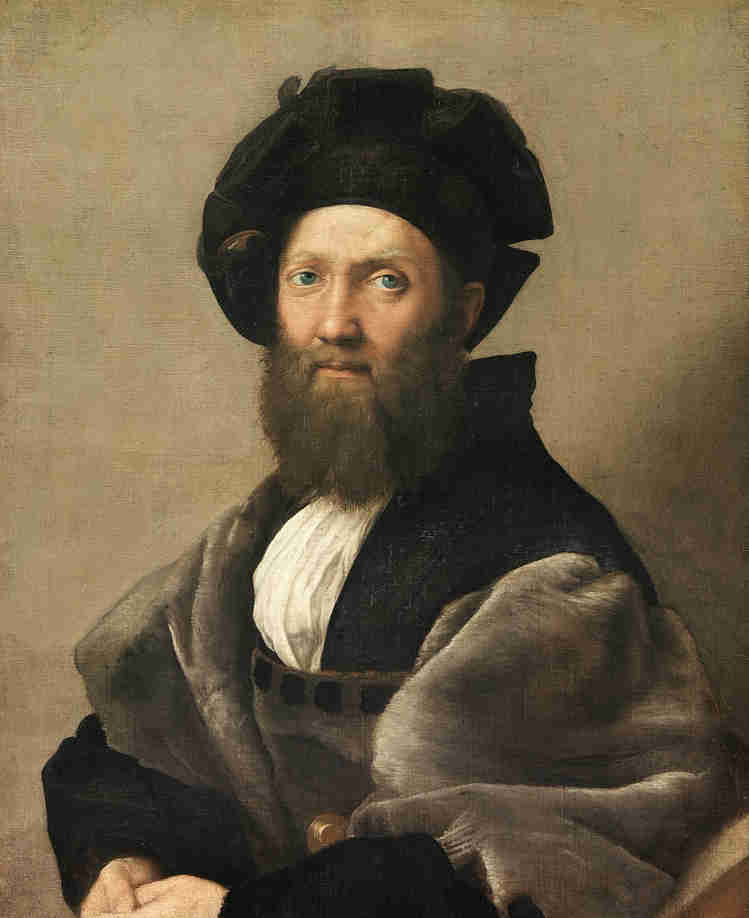
Raphael’s Portrait of Baldassare Castiglione
17. Portrait of Baldassare Castiglione, 1514-15 | Louvre Museum, Paris France
This portrait depicts Raphael’s friend, a humanist and high Renaissance gentleman in the courtyard of the Gonzaga in Mantua. When Pope Leo X was elected, Castiglione was sent to Rome as an ambassador of Urbino.
Castiglione is shown in 3/4 profile in a Leonardo-like pose, with just a hint of a Mona Lisa style smile. Raphael’s portrait showcases the elegance and restraint of dress that characterized an esteemed figure of the Renaissance.
Castiglione is seated against an earth toned background. He wears a dark doublet with a trim of squirrel fur and black ribbon. On his head is a turban topped by a beret.
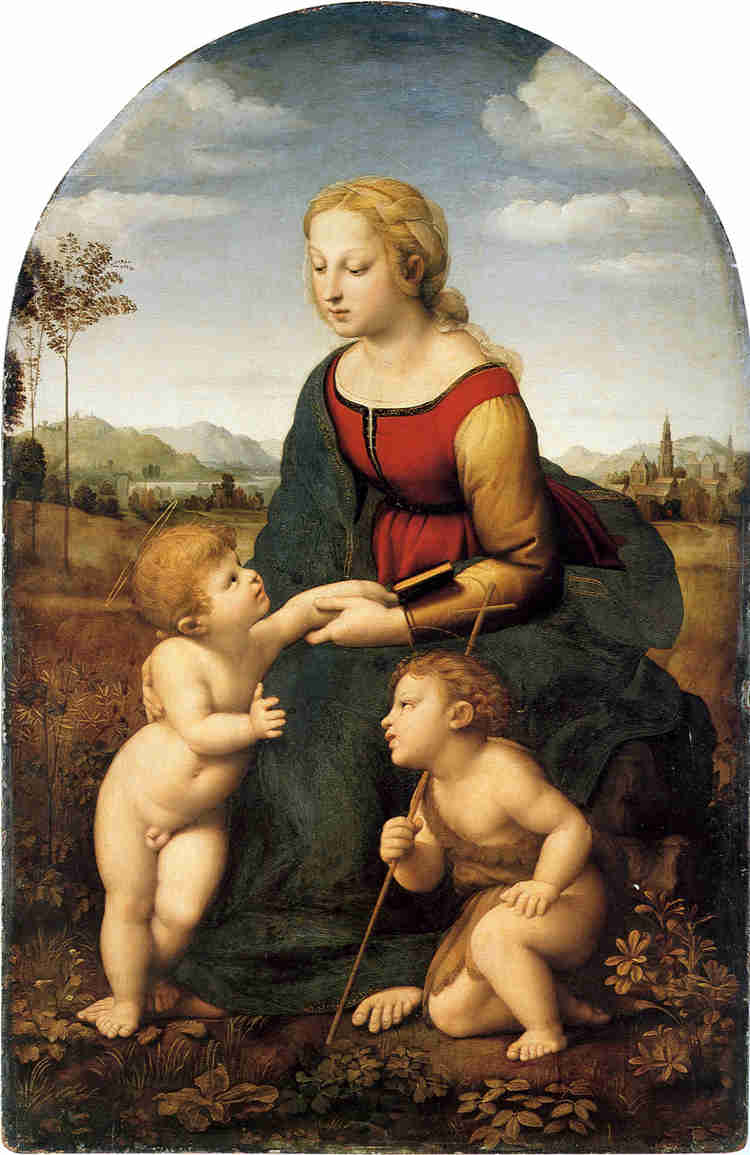
Raphael painting in the Louvre
18. The Virgin and Child With St. John the Baptist, 1507-08 | Louvre Museum, Paris France
La Belle Jardinière is the official name of this painting. It translates to the beautiful gardener. It’s one of Raphael’s most famous works from his early Florentine period.
Typical of the Italian High Renaissance period, the painting uses a pyramid composition. The three figures (Mary, Christ, and John the Baptist), form an invisible triangle. The composition thus draws the eye to the madonna, as the central figure of the painting
The figures all have faint halos. Mary’s arm is around Christ in a protective hold while she looks at him. He looks back up at her, staring on her with a look of trust. John the Baptist takes on his usual role as devotee, kneeling as he gazes at Christ.
Raphael left the painting unfinished when he moved to Rome. It’s believed to be completed by Florentine painter Ridolfo del Ghirlandaio. Raphael’s signature is on the edge of the Mary’s mantle.
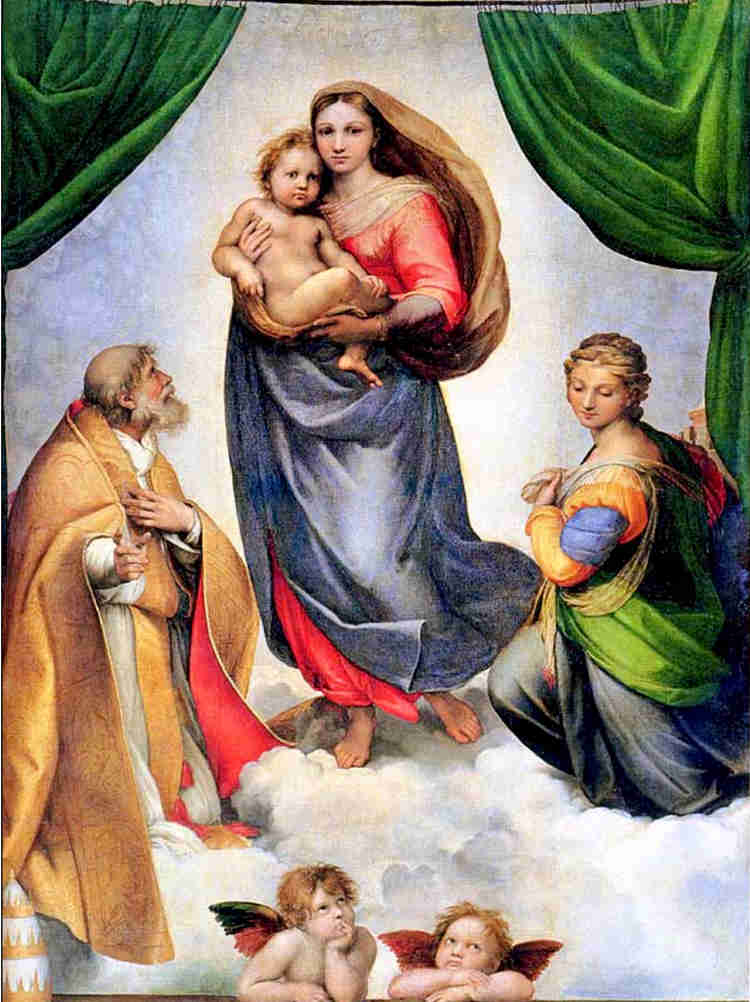
Raphael’s Sistine Madonna
19. The Sistine Madonna, 1512 | Gemäldegalerie Alte Meister, Dresden Germany
Commissioned by Pope Julius II, this famous painting is beloved by Raphael scholars. It depicts a madonna and child with St. Sixtus and St. Barbara kneeling on either side of them. They see a vision in the clouds.
Two adorable cherubs at the bottom of the painting look up at the group, without the usual reverence. The cherubs have achieved a kind of cult status, copied countless times on stamps and postcards. On the bottom left of the painting is the papal crown of Pope Sixtus.
The work was commissioned as an altarpiece for the Benedictine Monastery of San Sisto in Piacenza. Julius intended it as an homage to his uncle Pope Sixtus IV, the man who built the Sistine Chapel.
In the painting, Raphael used a common pyramidal composition. The curtains appear to be drawn back to reveal the heavenly scene. The figures have endearing expressions of warmth. Mary looks concerned and baby Jesus looks a bit afraid.
The piece is important because it was one of the last madonnas painted by Raphael before his untimely death. Art historians have dubbed this painting “supreme among the world’s paintings,” with the ability to arouse a state of religious ecstasy.
Raphael’s Marriage of the Virgin in Milan
20. Marriage of the Virgin, 1504 | Pinacoteca di Brera, Milan
This is a gem of a painting in the Brera Museum in Milan. Raphael was only 21 when he painted it. It’s a sophisticated work for such young artist.
Like other early Raphael works, this painting is reminiscent of his teacher, Pietro Perugino. It was clearly influenced by Perugino’s famous The Delivery of the Keys to Saint Peter in the Vatican Museums and by Perugino’s altarpiece of the same name in Caen.
The subject of the painting is a common Renaissance theme, from a medieval book called The Golden Legend. A priest marries Mary and Joseph in front of a temple in Jerusalem. The figures are gracefully rendered and clad in brightly colored clothes, typical of Raphael.
Carrying his magic rod, Joseph puts a wedding ring on Mary in a marriage ceremony. Joseph won Mary’s hand with this rod-branch, which miraculously blossomed during the competition of the suitors.
The people in Raphael’s painting seem somewhat secondary compared to the temple above. It’s an exercise in architectural realization. The temple is painted with such precision that it appears almost like a wooden model. On the arched peristyle, you can read Raphael’s signature.
Here’s my complete guide to Milan’s Pinacoteca di Brera.
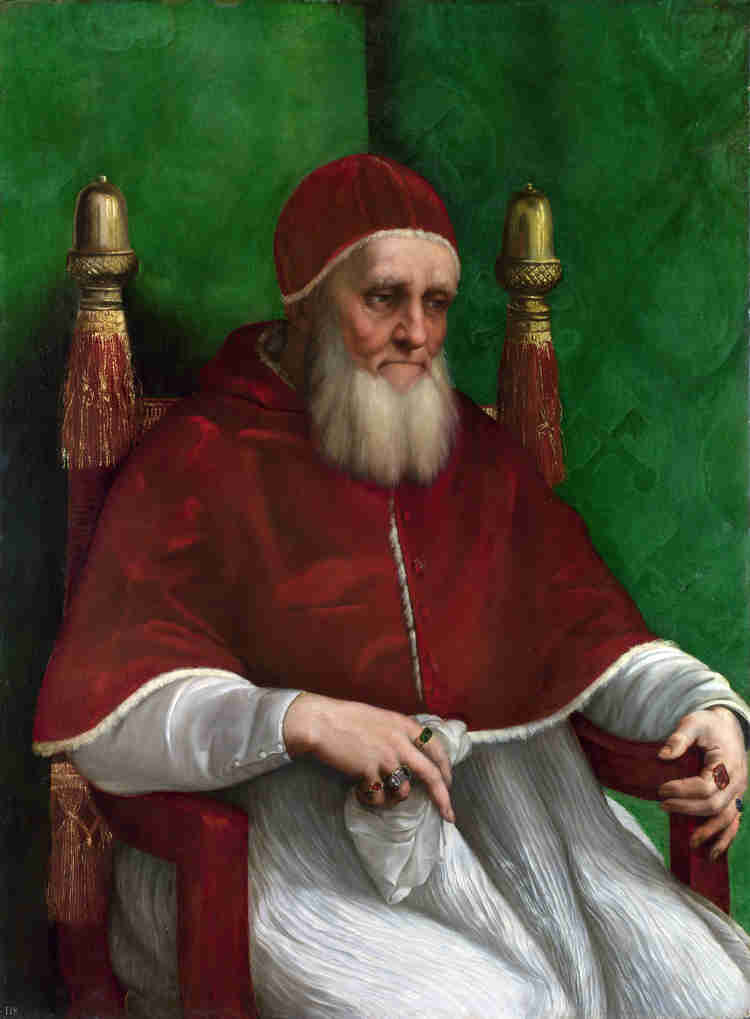
Raphael’s Portrait of Julius II
21. Portrait of Pope Julius II, 1512 | National Gallery, London England
Raphael got his first big career break in 1507, the Raphael Rooms, from Pope Julius II. Raphael had been recommended by the architect Bramante.
In 1512, he painted an intimate portrait of the great pope and art patron after his death. The portrait initially hung in the Church of Santa Maria del Popolo in Rome. When Vasari saw it, he exclaimed “it was so lifelike and true it frightened everybody who saw it, as if it were the living man himself.”
The pope is portrayed in three-quarters profile to the right, seated in an armchair. He’s melancholy and lost in through. It was unusual at the time to paint a pope in a particular mood. Julius was depressed because the city of Bologna had seceded from the papal states.
Raphael’s use of oil paint is almost unequalled in history. Look at the wrinkling of the skin as his left hand grips the throne, the flow of white fabric over his knees, and the sense of his wiry body inside his robes.
There are other copies of this famous painting in the Uffizi Gallery and the Borghese Gallery.
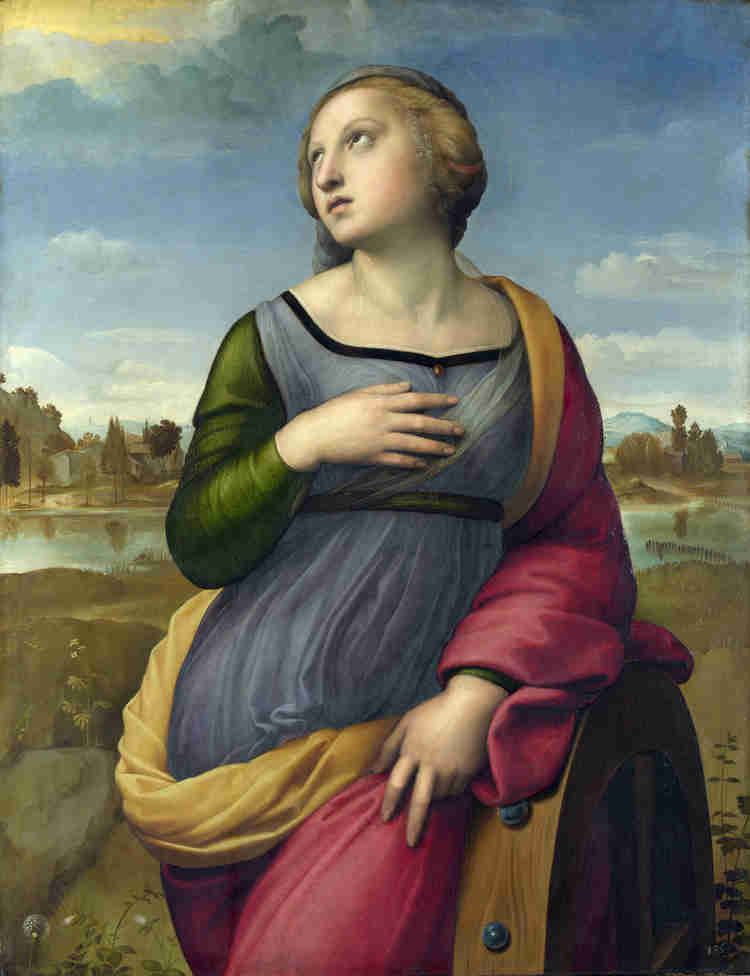
Raphael’s St. Catherine of Alexandria
22. St. Catherine of Alexander, 1507 | National Gallery, London England
Catherine of Alexandria, a 4th century princess, was an early convert to Christianity. In a vision, she underwent a mystic marriage with Christ. Catherine also successfully converted others.
This pissed off the anti-Christian Emperor Maxentius, the predecessor of Constantine. Maxentius tried to kill her with a spiked wheel, but she was miraculously saved by an angel. Maxentius then resorted to a more simple beheading.
Raphael’s painting focused on the saint’s vision. He paints Catherine with her hand on heart and her lips parted, in a moment of divine ecstasy looking up to heaven.
The saint’s twisting pose reflects Raphael’s study of the dynamic compositions of Leonardo and the monumentality of Michelangelo’s figures.
READ: Guide To Free Museums in London
Raphael portrait in the Prado
23. Portrait of a Cardinal 1510 | Prado Museum, Madrid Spain
There are quite a few Raphael pieces in the Prado. But perhaps the best is Portrait of a Cardinal.
The subject of this exquisite painting is unknown, thought the best guess is Cardinal Giovanni Alidosi. He has an enigmatic expression rather like the Mona Lisa in Paris’ Louvre.
But he was known as a ruthless man. And the severity and intensity of the portrait, with its stark colors, may reflect that.
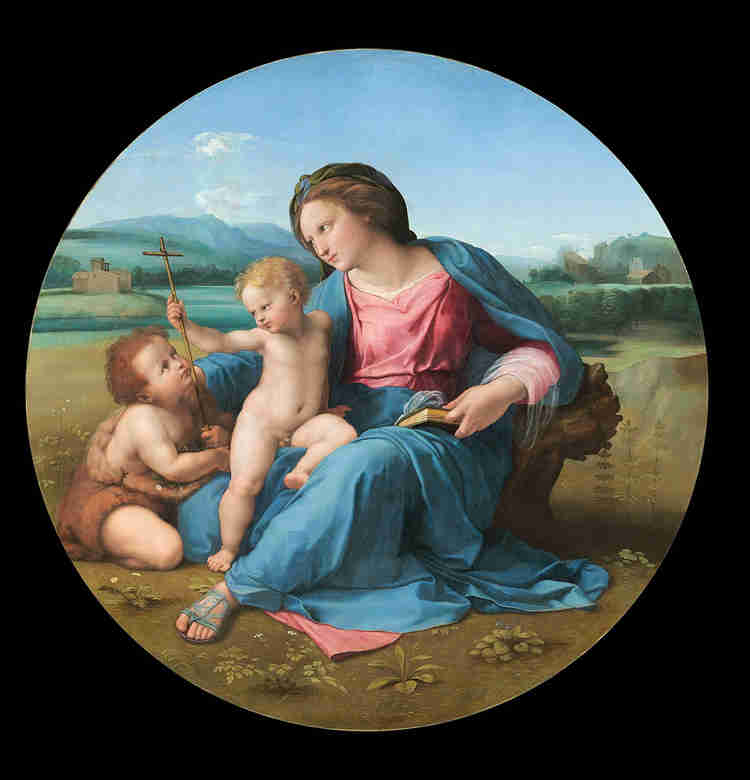
Raphael’s Alba Madonna, painted at the height of his powers
24. Alba Madonna, 1510 | National Gallery, Washington DC
Raphael has really come into his own at that point. This painting is stunningly beautiful. Mary looks almost like a Roman figure, with sandals.
She, Christ, and John the Baptist are arranged in a pyramidal composition. They all look at the cross set against a beautiful landscape of Tuscany.
There’s a monumentality and force to this painting that wasn’t present in Raphael’s earlier works. The painting is also full of symbolism.
Mary is shown wearing a blue mantle and blue sandals, representing the church. She’s wearing a red dress, representing Christ’s sacrifice.
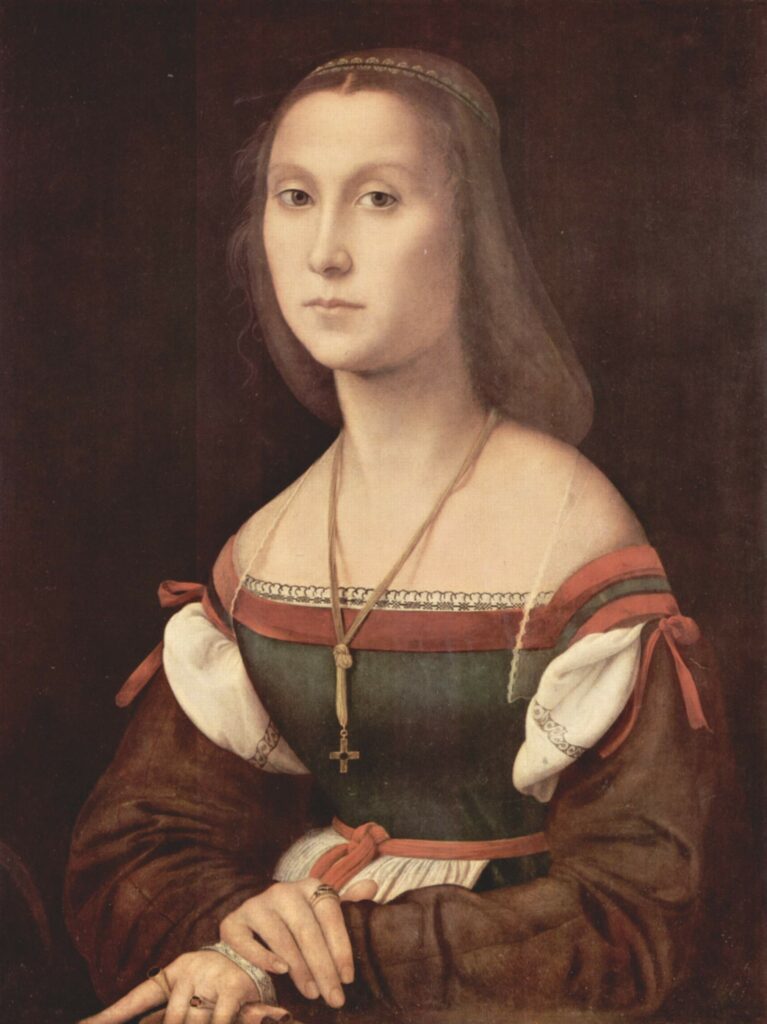
25. La Muta, 1507 | National Gallery of the Marche
La Muta is another famous Renaissance painting by Raphael. While it’s one of his early works, it has all the hallmarks of his mature style.
La Muta is a mysterious 3/4 view portrait of an unknown noblewoman. It might be Giovanna Feltra della Rovere, the daughter of the Duke of Montefeltro in Urbino.
She looks peaceful and graceful. Her expression is a bit sad, and her gaze is mysterious.
Interestingly, there was some confusion in the past about who painted it. Some thought it was Raphael’s teacher, Perugino. But now everyone agrees it’s Raphael’s creation.
Just like Raphael’s other works, this painting captures the subject’s emotions and thoughts in a way that makes you feel a connection with them. It’s a powerful piece of psychological art that tells a story without words.
I hope you’ve enjoyed my guide to Raphael’s best paintings. You may enjoy these other art and travel guides:
- Guide To the Best Art in Italy
- Best Small Museums With Supersized Collection
- Michelangelo Trail in Florence
- Leonardo da Vinci Trail in Milan
- Piero della Francesco Trail in Italy
- Andrea del Verrocchio’s Art in Florence
- Caravaggio Trail in Rome
- Bernini Trail in Rome
- Leonardo da Vinci’s Paintings
- Botticelli Trail in Florence
- Artemisia Gentileschi Paintings
If you’d like to see Raphael’s best paintings, pin it for later.

